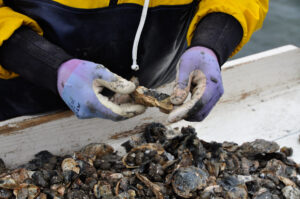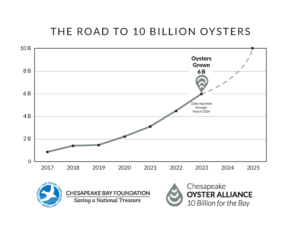 Following a banner year for Chesapeake Bay oyster restoration and aquaculture, the Chesapeake Oyster Alliance (COA) this week announced it has recorded a new total of 6 billion oysters directly added to the Bay since 2017.
Following a banner year for Chesapeake Bay oyster restoration and aquaculture, the Chesapeake Oyster Alliance (COA) this week announced it has recorded a new total of 6 billion oysters directly added to the Bay since 2017.
COA’s count aims to include all oysters directly added to the Bay and its tributaries through restoration and aquaculture. These efforts have now surpassed the halfway mark to the group’s goal to promote adding 10 billion new oysters to the Bay by 2025.
The majority of contributions toward the 10 billion oyster goal come from major restoration initiatives in Maryland and Virginia targeted towards 11 Bay tributaries, which are on track to be completed by 2025.
“We’re seeing an exciting oyster renaissance on the Bay, from massive tributary scale-efforts down to widespread citizen involvement and public awareness. At least six billion oysters have been added to the Chesapeake in recent years thanks to heroic work by Maryland and Virginia, federal partners, and COA aquaculture and restoration partners,” said Tanner Council, COA Senior Manager for the Chesapeake Bay Foundation. “Each year, the Chesapeake Bay is getting closer to an extremely ambitious goal of adding 10 billion new oysters.”
The 2023 oyster count in Maryland was elevated by a record year for oyster restoration thanks to large-scale restoration work by the Maryland Department of Natural Resources (DNR), National Oceanic and Atmospheric Administration, U.S. Army Corps of Engineers, and Oyster Recovery Partnership.
In Virginia, an outstanding year for oyster aquaculture saw a total of about 119 million oysters recorded in the Commonwealth in 2023. Virginia aquaculture numbers in recent years range from a low of 86 million in 2020 to a high of 129 million in 2022. Oyster aquaculture operations raise these oysters to sell to restaurants and consumers, supporting local economies while filtering water and creating habitat.
A significant number of oysters were also added through small-scale restoration work and the efforts of individuals and small businesses through programs like oyster gardening. These efforts are a great example of how the people and partners throughout the region have embraced the many benefits of oyster restoration and aquaculture.
The Chesapeake Bay Foundation (CBF) founded the Chesapeake Oyster Alliance in 2018 to spark momentum and innovation to bring back oysters from historically low levels. COA has grown to include more than 110 nonprofits, academic institutions, businesses, and aquaculture operations. Together, these partners advocate for accelerating oyster restoration, science-based fisheries management and expanding the oyster aquaculture industry throughout the Bay.
To support progress in oyster restoration and aquaculture, COA promotes research and new approaches through oyster innovation grants, restoration funding, facilitating collaborations between partners, and an annual Chesapeake Oyster Science Symposium. Strong coalitions such as COA are key to long-term success in restoring a keystone species like the Bay oyster.
“Having now surpassed the halfway mark, we are more motivated than ever to maintain momentum and accelerate progress by building support, innovation, and partnerships,” Council said.
In January 2024, COA also announced its most recent Oyster Innovation Awards, totaling $140,000 for 15 organizations making progress in oyster-related research, technologies, reproduction, educational opportunities, and more. This is the fourth consecutive year of similar grant distributions under the COA Oyster Innovation Awards
Oysters filter water and form reefs that provide essential habitat for countless other species. They also support the region’s recreational and commercial fisheries, and the Bay’s local economy and culture. Despite oysters’ critical role, their population is just a small fraction of what it once was. Restoration efforts and aquaculture in the Chesapeake Bay are critical to bringing back this keystone species.
Vanessa Remmers, Virginia Communications & Media Relations Manager, CBF


